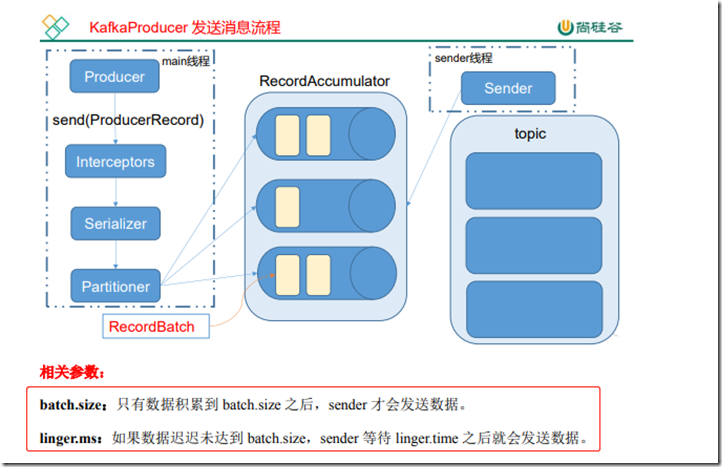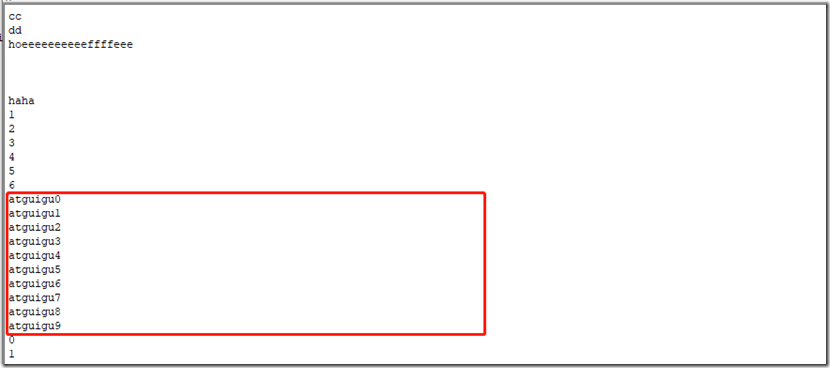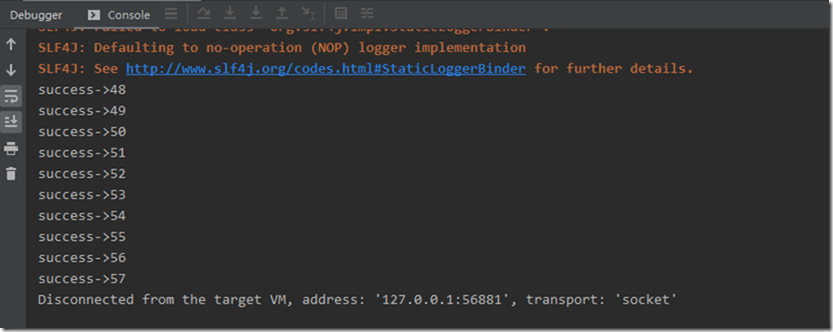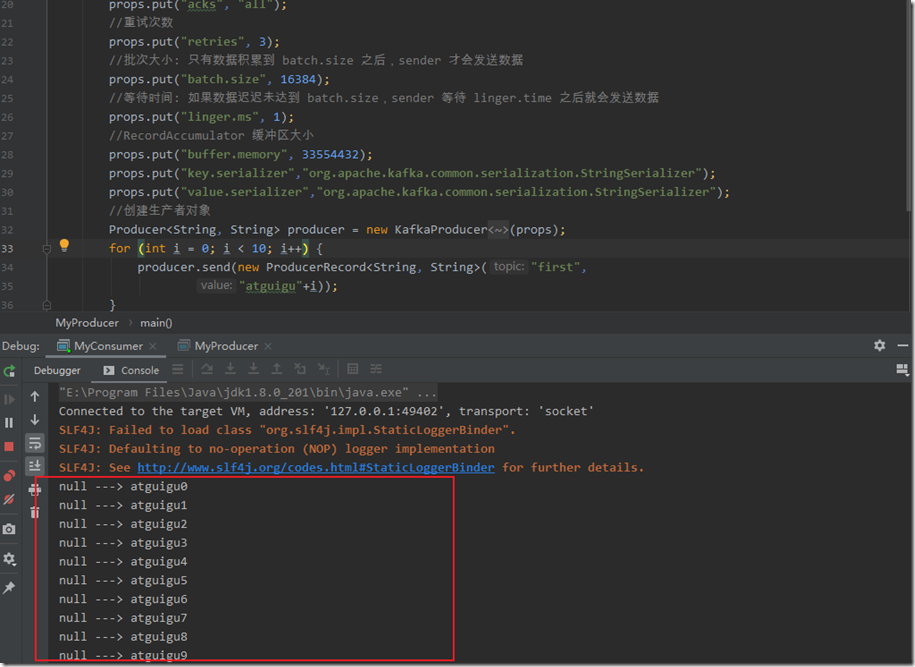1、Producer API
1)消息发送流程
Kafka 的 Producer 发送消息采用的是异步发送的方式。在消息发送的过程中,涉及到了 两个线程——main 线程和 Sender 线程,
以及一个线程共享变量——RecordAccumulator。 main 线程将消息发送给 RecordAccumulator,Sender 线程不断从 RecordAccumulator
中拉取 消息发送到 Kafka broker
2)异步发送API
①、依赖
<dependency>
<groupId>org.apache.kafka</groupId>
<artifactId>kafka-clients</artifactId>
<version>0.11.0.0</version>
</dependency>②、不带回调函数的api
public class MyProducer { public static void main(String[] args) { Properties props = new Properties(); //kafka 集群,broker-list props.put("bootstrap.servers", "121.40.182.123:9092"); props.put("acks", "all"); //重试次数 props.put("retries", 3); //批次大小: 只有数据积累到 batch.size 之后,sender 才会发送数据 props.put("batch.size", 16384); //等待时间: 如果数据迟迟未达到 batch.size,sender 等待 linger.time 之后就会发送数据 props.put("linger.ms", 1); //RecordAccumulator 缓冲区大小 props.put("buffer.memory", 33554432); props.put("key.serializer","org.apache.kafka.common.serialization.StringSerializer"); props.put("value.serializer","org.apache.kafka.common.serialization.StringSerializer"); //创建生产者对象 Producer<String, String> producer = new KafkaProducer<String, String>(props); for (int i = 0; i < 10; i++) { System.out.println(i); producer.send(new ProducerRecord<String, String>("first", "atguigu"+i)); } producer.close(); } }
用kafka的命令行方式启动消费者来消费消息
bin/kafka-console-consumer.sh --bootstrap-server 127.0.0.1:9092 --from-beginning --topic first
可以看到消费到生产的消息
③ 带回调函数的api
回调函数会在 producer 收到 ack 时调用,为异步调用,该方法有两个参数,分别是 RecordMetadata 和 Exception,如果 Exception 为 null,
说明消息发送成功,如果 Exception 不为 null,说明消息发送失败。
注意:消息发送失败会自动重试,不需要我们在回调函数中手动重试
public class MyCallBackProducer { public static void main(String[] args) { Properties props = new Properties(); props.put("bootstrap.servers", "121.40.182.123:9092");//kafka 集群,broker-list props.put("acks", "all"); props.put("retries", 1);//重试次数 props.put("batch.size", 16384);//批次大小 props.put("linger.ms", 1);//等待时间 props.put("buffer.memory", 33554432);//RecordAccumulator 缓 冲区大小 props.put("key.serializer","org.apache.kafka.common.serialization.StringSerializer"); props.put("value.serializer","org.apache.kafka.common.serialization.StringSerializer"); Producer<String, String> producer = new KafkaProducer<String, String>(props); for (int i = 0; i < 10; i++) { producer.send(new ProducerRecord<String, String>("first", Integer.toString(i), Integer.toString(i)), new Callback() { //回调函数,该方法会在 Producer 收到 ack 时调用,为异步调用 @Override public void onCompletion(RecordMetadata metadata, Exception exception) { if (exception == null) { System.out.println("success->" + metadata.offset()); } else { exception.printStackTrace(); } } }); } producer.close(); } }
idea控制台
消费者消费到的消息
④【扩展】自定义分区的生产者
自定义分区器
public class MyPartitioner implements Partitioner { @Override public int partition(String s, Object o, byte[] bytes, Object o1, byte[] bytes1, Cluster cluster) { return 1; } @Override public void close() { } @Override public void configure(Map<String, ?> map) { } }
在生产者中指定分区器
//添加分区器 props.put("partitioner.class", "com.atguigu.producer.MyPartitioner") public class MyPartitionerProducer { public static void main(String[] args) { Properties props = new Properties(); //kafka 集群,broker-list props.put("bootstrap.servers", "121.40.182.123:9092"); props.put("acks", "all"); //重试次数 props.put("retries", 3); //批次大小: 只有数据积累到 batch.size 之后,sender 才会发送数据 props.put("batch.size", 16384); //等待时间: 如果数据迟迟未达到 batch.size,sender 等待 linger.time 之后就会发送数据 props.put("linger.ms", 1); //RecordAccumulator 缓冲区大小 props.put("buffer.memory", 33554432); props.put("key.serializer","org.apache.kafka.common.serialization.StringSerializer"); props.put("value.serializer","org.apache.kafka.common.serialization.StringSerializer"); //添加分区器 props.put("partitioner.class", "com.atguigu.producer.MyPartitioner"); //创建生产者对象 Producer<String, String> producer = new KafkaProducer<String, String>(props); for (int i = 0; i < 10; i++) { producer.send(new ProducerRecord<String, String>("first", "atguigu"+i) , new Callback() { //回调函数,该方法会在 Producer 收到 ack 时调用,为异步调用 @Override public void onCompletion(RecordMetadata metadata, Exception exception) { if (exception == null) { System.out.println("success->" + metadata.offset()); } else { exception.printStackTrace(); } } }); } producer.close(); } }
3)同步发送 API
在sender线程发送消息时阻塞 main线程,当发送完消息后,再放开main线程
public class MyProducer1 { public static void main(String[] args) throws ExecutionException, InterruptedException { Properties props = new Properties(); props.put("bootstrap.servers", "hadoop102:9092");//kafka 集群,broker-list props.put("acks", "all"); props.put("retries", 1);//重试次数 props.put("batch.size", 16384);//批次大小 props.put("linger.ms", 1);//等待时间 props.put("buffer.memory", 33554432);//RecordAccumulator 缓冲区大小 props.put("key.serializer", "org.apache.kafka.common.serialization.StringSerializer"); props.put("value.serializer", "org.apache.kafka.common.serialization.StringSerializer"); Producer<String, String> producer = new KafkaProducer<String, String>(props); for (int i = 0; i < 100; i++) { producer.send(new ProducerRecord<String, String>("first", Integer.toString(i), Integer.toString(i))).get(); } producer.close(); } }
2、consumer API
Consumer消费数据时的可靠性是很容易保证的,因为数据在Kafka中是持久化的,故不用担心数据丢失问题
由于consumer在消费过程中可能出现断电宕机等故障,consumer恢复后,需要从故障前的位置继续消费,所以
consumer需要实时记录自己消费到了哪个offset,以便故障恢复后继续消费
所以 offset的维护是Consumer消费数据必须考虑的问题
1)自动提交 offset
为了使我们能够专注于自己的业务逻辑,Kafka 提供了自动提交 offset 的功能。
自动提交 offset 的相关参数
enable.auto.commit:是否开启自动提交 offset 功能
auto.commit.interval.ms:自动提交 offset 的时间间隔
public class MyProducer { public static void main(String[] args) { Properties props = new Properties(); //kafka 集群,broker-list props.put("bootstrap.servers", "121.40.182.123:9092"); props.put("acks", "all"); //重试次数 props.put("retries", 3); //批次大小: 只有数据积累到 batch.size 之后,sender 才会发送数据 props.put("batch.size", 16384); //等待时间: 如果数据迟迟未达到 batch.size,sender 等待 linger.time 之后就会发送数据 props.put("linger.ms", 1); //RecordAccumulator 缓冲区大小 props.put("buffer.memory", 33554432); props.put("key.serializer","org.apache.kafka.common.serialization.StringSerializer"); props.put("value.serializer","org.apache.kafka.common.serialization.StringSerializer"); //创建生产者对象 Producer<String, String> producer = new KafkaProducer<String, String>(props); for (int i = 0; i < 10; i++) { producer.send(new ProducerRecord<String, String>("first", "atguigu"+i)); } producer.close(); } }
利用上面的生产者生产消息,此消费者可以消费到数据
【扩展】
消费者重置 offset
//重置消费者的offset
properties.put(ConsumerConfig.AUTO_OFFSET_RESET_CONFIG, "earliest");
【注意】此属性生效是有条件的
2)手动提交offset
虽然自动提交 offset 十分简介便利,但由于其是基于时间提交的,开发人员难以把握 offset 提交的时机。因此 Kafka 还提供了手动提交 offset 的 API。
手动提交 offset 的方法有两种:分别是 commitSync(同步提交)和 commitAsync(异步 提交)。
两者的相同点是,都会将本次 poll 的一批数据最高的偏移量提交;
不同点是, commitSync 阻塞当前线程,一直到提交成功,并且会自动失败重试(由不可控因素导致, 也会出现提交失败);而 commitAsync 则没有失败重试机制,
故有可能提交失败
①、 同步提交
需要先关闭自动提交的属性
public class MyConsumer { public static void main(String[] args) { //1、创建消费者的配置信息 Properties properties = new Properties(); properties.put(ConsumerConfig.BOOTSTRAP_SERVERS_CONFIG, "121.40.182.123:9092"); //开启自动提交 properties.put(ConsumerConfig.ENABLE_AUTO_COMMIT_CONFIG, false); // 1s中提交一次offset properties.put(ConsumerConfig.AUTO_COMMIT_INTERVAL_MS_CONFIG, "1000"); //k v 的反序列化 properties.put(ConsumerConfig.KEY_DESERIALIZER_CLASS_CONFIG, "org.apache.kafka.common.serialization.StringDeserializer"); properties.put(ConsumerConfig.VALUE_DESERIALIZER_CLASS_CONFIG, "org.apache.kafka.common.serialization.StringDeserializer"); //设置消费者组 properties.put(ConsumerConfig.GROUP_ID_CONFIG, "bigdata3"); //重置消费者的offset // properties.put(ConsumerConfig.AUTO_OFFSET_RESET_CONFIG, "earliest"); KafkaConsumer<String, String> consumer = new KafkaConsumer<String, String>(properties); //订阅主题 consumer.subscribe(Arrays.asList("first")); while (true){ //拉取数据 ConsumerRecords<String, String> consumerRecords = consumer.poll(100); for (ConsumerRecord<String, String> consumerRecord : consumerRecords) { System.out.println(consumerRecord.key() + " ---> " + consumerRecord.value()); } //同步提交,当前线程会阻塞到offset成功 consumer.commitSync(); } } }
②、异步提交
public class MyConsumer2 { public static void main(String[] args) { //1、创建消费者的配置信息 Properties properties = new Properties(); properties.put(ConsumerConfig.BOOTSTRAP_SERVERS_CONFIG, "121.40.182.123:9092"); //开启自动提交 properties.put(ConsumerConfig.ENABLE_AUTO_COMMIT_CONFIG, false); // 1s中提交一次offset properties.put(ConsumerConfig.AUTO_COMMIT_INTERVAL_MS_CONFIG, "1000"); //k v 的反序列化 properties.put(ConsumerConfig.KEY_DESERIALIZER_CLASS_CONFIG, "org.apache.kafka.common.serialization.StringDeserializer"); properties.put(ConsumerConfig.VALUE_DESERIALIZER_CLASS_CONFIG, "org.apache.kafka.common.serialization.StringDeserializer"); //设置消费者组 properties.put(ConsumerConfig.GROUP_ID_CONFIG, "bigdata"); //重置消费者的offset // properties.put(ConsumerConfig.AUTO_OFFSET_RESET_CONFIG, "earliest"); KafkaConsumer<String, String> consumer = new KafkaConsumer<String, String>(properties); //订阅主题 consumer.subscribe(Arrays.asList("first")); while (true){ //拉取数据 ConsumerRecords<String, String> consumerRecords = consumer.poll(100); for (ConsumerRecord<String, String> consumerRecord : consumerRecords) { System.out.println(consumerRecord.key() + " ---> " + consumerRecord.value()); } //异步提交 consumer.commitAsync(new OffsetCommitCallback() { @Override public void onComplete(Map<TopicPartition,OffsetAndMetadata> offsets, Exception exception) { if (exception != null) { System.err.println("Commit failed for" + offsets); } } }); } } }
③、消费漏数据和重复消费
无论是同步提交还是异步提交 offset,都有可能会造成数据的漏消费或者重复消费。
先 提交 offset 后消费,若此时服务挂掉,则会丢失数据
先消费后提交 offset,若此时服务挂掉,重启后有可能会造成数据 的重复消费。
3)自定义存储offset
====== 还没有总结 ========




